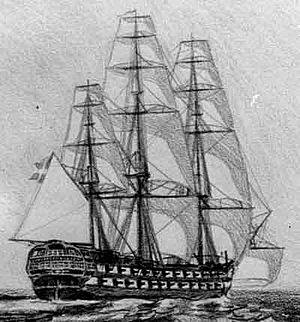HDMS Holsteen facts for kids

A contemporary drawing of Holsteen
|
|
Quick facts for kids History |
|
|---|---|
| Name | Holsteen or Holsten |
| Builder | Frederik Michael Krabbe, Nyholm, Copenhagen |
| Laid down | 23 March 1770 |
| Launched | 11 April 1772 |
| Commissioned | 1775 |
| Out of service | 2 April 1801 |
| Fate | Taken by the British at first Battle of Copenhagen (1801) |
| Name | Holstein, renamed Nassau in 1805 |
| Acquired | By capture by the British at first Battle of Copenhagen (1801) |
| Honours and awards |
Naval General Service Medal with clasp "Nassau 22 March 1808" |
| Fate | Sold 1814 |
| General characteristics | |
| Class and type | Holsteen-class ship of the line |
| Displacement | 1.01 Læster (=2,020 tons) |
| Tons burthen | 139474⁄94 (bm) |
| Length | 48.65 m (159.6 ft) |
| Beam | 13.70 m (44.9 ft) |
| Draught | 6.04 m (19.8 ft) |
| Sail plan | Full-rigged ship |
| General characteristics (Danish service) | |
| Complement | 373–470 crew, plus 100 soldiers |
| Armament |
|
| General characteristics (British service) | |
| Complement | 491 seamen and marines |
| Armament |
|
Holsteen was a powerful warship with 60 guns, built for the Royal Dano-Norwegian Navy. She started active duty in 1775. In 1801, during a big battle in Copenhagen, the British Royal Navy captured her. They first called her HMS Holstein, and then later HMS Nassau. This ship was involved in an important battle during the Gunboat War before being sold in 1814.
Contents
Ship Design and Build
Holsteen was the lead ship of her class, meaning other ships were built based on her design. The main designer and builder for the Danish navy was Frederik Michael Krabbe. She was a bit narrower than other similar ships of her time, like those in the Oldenborg-class.
In 1775, Holsteen was prepared for a trip to Norway. There, she served as a command ship for other vessels that were docked. She then returned to Copenhagen in 1776.
From May 1776 to July 1780, Holsteen sailed to places like Lisbon, the Gold Coast (in Africa), and Cape Town. When she returned in July 1780, she worked as a guardship near Copenhagen until October of that year.
Later, from 1782 to 1783, Holsteen was part of the Neutrality Squadron. This group of ships helped protect trade during times of war. She also joined squadrons in 1794 and 1795 in the Øresund area and the North Sea.
In 1801, Holsteen was set up as a "blockship." This meant she was placed in a defensive line to block enemy ships. She took part in the Battle of Copenhagen on April 2, 1801. During the battle, she was positioned at the northern end of the Danish defense line. Around 2:15 PM, her captain had to surrender the ship to the British forces.
After being captured, the British sent Holstein back to Britain on April 12. She was the only Danish warship the British decided to keep, as they saw the others as mostly just floating gun platforms. She helped transport wounded soldiers and arrived at Yarmouth on April 22.
Holstein was kept in storage until July 1802. Then, in October 1802, she was moved to Chatham. Between March and September 1805, the ship underwent major repairs at a cost of £22,022. She was then renamed HMS Nassau. In September, Captain Robert Campbell took command, and she began serving in the North Sea.
On April 18, 1806, Nassau and several other British ships captured a Prussian ship called Jonge Bartels. A few days later, Nassau captured another ship, the Vissery. On May 2, Nassau and another ship, HMS Stately, captured the Nicholai and Martha. From May to June 1807, she escorted a group of merchant ships to Madeira.
In late 1807, Nassau returned to Copenhagen for the second Battle of Copenhagen. After the Danish fleet surrendered, Nassau was one of the ships that escorted the captured Danish vessels from Holmen to Kronborg on October 21, 1807. She stayed in Danish waters until February 1809.
Battle of Zealand Point
On March 22, 1808, Nassau and the 64-gun HMS Stately fought and destroyed the last Danish ship of the line, HDMS Prinds Christian Frederik. This battle took place at Zealand Point.
During this battle, Nassau had one sailor killed, one missing, and 16 wounded. Years later, in 1847, a special medal called the Naval General Service Medal was given to any surviving crew members of Nassau and Stately who had fought in this battle.
More Captures in 1808
On April 19, 1808, Stately and Nassau captured two more Danish ships, the Industrie and the Haabet Anker.
On September 1, 1809, Nassau was escorting a group of large merchant ships in the English Channel. She spotted a strange ship and sent her smaller boats to chase it. After two hours, they captured a French privateer ship called Jean Bart. This ship was armed with four guns and had a crew of 25 men. It had been at sea for five days but hadn't captured any ships.
Ship's Final Days
Nassau was put into storage at Chatham in September 1809. In March of the next year, she was used as a prison ship under the command of Lieutenant William Field. She served in this role until she was sold for £2,510 on November 3, 1814.
See also
- List of ships captured in the 19th century




